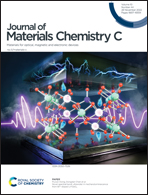Solution-processable star-shaped small molecules for efficient organic RRAM by induced conductive filament mechanism†
Abstract
To investigate how different core and end-capping moieties affect the thin-film morphology and memory performance of star-shaped molecules, five molecules BPPT, TPPT, TPPA, tBu-TPPT and tBu-TPPA were synthesized, which consist of the same branched groups, but have different core units with different electronic effects, namely, 1,3,5-triphenylbenzene, 2,4,6-triphenyl-1,3,5-triazine and triphenylamine. Among them, the devices based on TPPT, TPPA, tBu-TPPT and tBu-TPPA containing nitrogen heteroatoms show nonvolatile binary write-once-read-many-times (WORM) memory behaviours. Notably, the tBu-TPPA based devices display the highest ION/IOFF ratio (105) and the lowest threshold voltage (1.45 V). We propose that the resistive switching characteristic of these materials is due to the Al filament conduction mechanism induced by N atoms. These results suggest that introducing the N heteroatoms into molecules can not only adjust the intermolecular interactions and thin film morphology, but also help to the formation of metal filament, which thus changes the resistive memory behaviour. Due to its dependable and stable storing properties, the as-fabricated WORM device based on tBu-TPPA was also applied to the operation of logic gates and information displays, showing significant potential for national security and patient confidentiality in hospitals.



 Please wait while we load your content...
Please wait while we load your content...